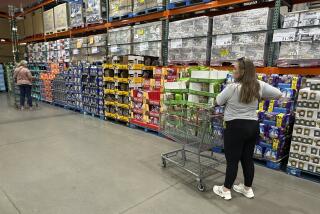Consumer Borrowing Jumps 2.7% : Economy: September increase in installment credit reverses 7 straight months of debt shrinkage. Analysts are hopeful that spending surge will fuel recovery.
- Share via
After steadily paying down debts for seven months, consumers increased their borrowing in September, a sign that the nation’s economy may be improving, the Federal Reserve said Friday.
The Fed said credit card tabs, auto loans and other forms of installment credit rose by $1.61 billion in September, at an annual rate of 2.7%. That was a turnaround after seven straight months in which consumer credit shrank as Americans concentrated on paying down their debts rather than taking on new ones.
But in California, where the economy has been crippled by layoffs in aerospace and falling real estate prices, consumers are decidedly less optimistic than in the rest of the country.
“If you think of it as a roller coaster, California is near the bottom of the hill,” said John Hekman of Economic Analysis Corp. in Century City. “We are not falling quite as rapidly as we were, but we are on a different track” from the rest of the country.
However, economists said they were encouraged by the surge in consumer borrowing nationwide. “Consumers are starting to feel better and they seem willing to take on some additional debt,” said economist Sung Won Sohn of Norwest Corp. in Minneapolis.
Sohn said it was too soon to predict whether consumers would continue spending after a long period of paying down debt. “At best we can expect to see a bottoming out in the process,” he said.
The pace of consumer borrowing is closely watched by economists trying to predict the strength and timing of the nation’s economic recovery.
Consumer spending fuels two-thirds of national economic activity and is widely viewed as the engine needed to get the economy moving again.
Through most of the year, high unemployment, fears about the economy’s direction and an already high household debt burden have kept consumers from spending, cramping the economy’s potential for growth. The question is whether consumers have reduced their old debts enough to take on new ones.
Some economists argue that consumers are still too deeply in debt from the 1980s to trigger a spending boom. They argue that instead of paying down debt, many consumers have shifted it around, trading credit card debt for lower rate home equity loans, for example.
The Fed said that for the nation, revolving, or “credit-card” credit, jumped by $1.82 billion, more than double the $711-million growth in this category of credit in August. That was consistent with reports from major retailers on Thursday who said their business picked up in October after being sluggish earlier. The big chain stores are hoping for a strong Christmas shopping season after several bad years.
“We’re seeing a gradual improvement in consumer spending, at least compared to last year,” said C.J. Lawrence analyst Jeffrey Edelman after retailers said October business was up by an average 7% to 8% from the same period last year.
In September, auto credit expanded by $909 million as consumers bought more new cars on credit.
More to Read
Inside the business of entertainment
The Wide Shot brings you news, analysis and insights on everything from streaming wars to production — and what it all means for the future.
You may occasionally receive promotional content from the Los Angeles Times.










